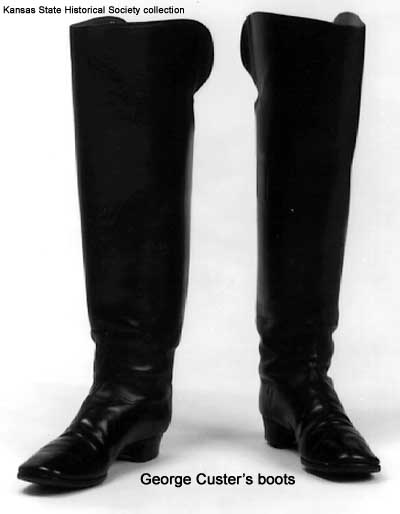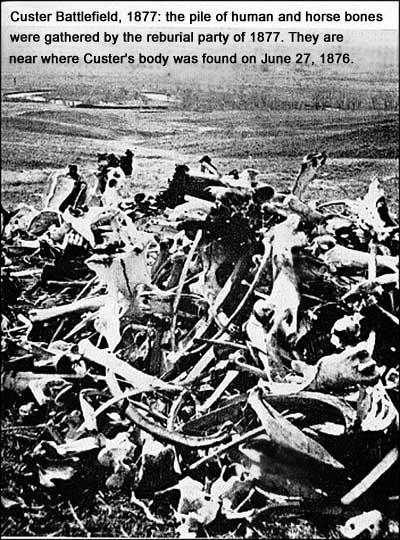|
|||||||
Bruce Brown's 100 Voices... Edward S. Godfrey Recalls What Custer
This eye-witness account by Little Bighorn survivor Edward S. Godfrey -- together with the accounts of suviors Peter Thompson and the Arikara scout Soldier -- provide the best information on what Custer wore. It turns out there were six or more officers in buckskin that fateful day, but George A. Custer was the only one riding a sorel horse with four white socks. This is crucial because a young Sioux warrior named White Cow Bull said he shot an officer in buckskin with a big hat off a sorel horse with four white socks -- this can only be Custer, although White Cow Bull didn't know that -- when the American Seventh Cavalry attempted to charge across the Little Bighorn River at Medicine Tail Coulee and attack the village at the outset of the Custer fight. See Who Killed Custer: The Eye-Witness Answer for more info. -- Bruce Brown E.S. GODFREY DESCRIBES MOUNTS, UNIFORMS AND EQUIPMENT
"1st: Gen. Custer rode "Vic" into the fight; Vic was a sorrel, with four white feet and legs and a blaze in the face; he was not found on the field. I have heard that he had been identified in the possession of some Indian in the hostile camp after they went into the British possessions. [Note: Iron Hail said Custer's horse was taken by a Santee Sioux named Walks Under The Ground, while Lazy White Bull and others said the Santee's name was Noisy Walking (not to be confused with Cheyenne chief Ice Bear's young son of the same name, who was killed at the Battle of the Little Bighorn) and Turning Hawk said Little Buffalo got Custer's horse.] The dogs were left with the wagon train. 2nd: General Custer carried a Remington Sporting rifle, octagonal barrel; two Bulldog selfcocking, English, white-handled pistols, with a ring in the butt for a lanyard; a hunting knife, in a beaded fringed scabbard; and a canvas cartridge belt. He wore a whitish gray hat, with broad brim and rather low crown, very similar to the Cowboy hat; buck skin suit, with a fringed welt in outer seams of trousers and arms of blouse; the blouse with double-breasted military buttons, lapels generally open; turn-down collar, and fringe on bottom of shirt. [Note: Here is Peter Thompson's decription of Custer's appearance just before the Custer fight began. Thompson was the last Seventh Cavalry trooper to see Custer alive.] 3rd: Captain Tom Custer was dressed about the same as the General. He was found near the top of the hill, north, and a few yards from the General, lying on his face; his features were so pressed out of shape as to be almost beyond recognition; a number of arrows had been shot in his back, several in his head, one I remember, without the shaft, the head bent so that it could hardly be withdrawn; his skull was crushed and nearly all the hair scalped, except a very little on the nape of the neck. The General was not mutilated at all; he laid on his back, his upper arms on the ground, the hands folded or so placed as to cross the body above the stomach; his position was natural and one that we had seen hundreds of times while taking cat naps during halts on the march. One hit was in the front of the left temple, and one in the left breast at or near the heart. Boston, the youngest brother was dressed similar to the other brothers, his body was found about two hundred yards from "Custer Hill," between that and the Little Big Horn, at the foot of the ridge that runs up from the river, and as it were, forms the lower boundary of the battlefield. The body was stript except his white cotton socks and they had the name cut off.
All of the officers wore the dark blue shirt with rather wide falling collar, which when the blouse was worn, was over the blouse collar; most of them had cross-sabers and 7, like the old cap ornament, worked in white or yellow silk on the points of the collar. Yates, Cooke, Smith, Porter and Calhoun, and sometimes Keogh, wore buckskin blouses, but I don't think any of them wore other than blue trousers; Harrington wore the blue blouse and white canvas trousers, with fringe on the outer seams. The day was very warm and few had any kind of blouse. In describing the dress, I give it as generally worn, for when the bodies were found, after the fight, they were stript. I found Porter's buckskin blouse in the village, while destroying the property, and from the shot holes in it, he must have had it on and must have been shot from the rear, left side, the bullet coming out on the left breast near the heart. Dr. Lord and Lieutenants Sturgis and Reilley wore the blue; Dr. Lord wore eye-glasses. Sergeant Robert Hughes of Troop K, who carried the General's battle flag, was killed near the General on the hill. Nearly all the men wore the blue, but many, perhaps most of them, had their trousers reenforced with white canvas on the seat and on the legs from the knees half way up. Nearly every one wore the short top boot (that was then uniform) not high like those now worn, although a few of the officers wore the Wellington boot and had white canvas leggings. 5th: The command was armed with the Springfield and the Colt revolver; every officer carried a revolver. NO ONE CARRIED THE SABER. (Nearly every illustration I have seen of that fight or campaign have had the officers and men armed with the saber. Adams' painting of "Custer's Last Fight," last winter presented to the regiment by Mr. Busch, has the men armed with the Winchester and the saber. In a historical painting, I think, if I may be allowed the suggestion, that the equipments, etc. should conform to those used at the time of the fight.) The bridles were different from the present pattern; the carbine socket was a small sack about 20 inches long in which was carried about 12 pounds of oats, strapped on the cantel (sic); there was no hood on the stirrup used by the men.
Troops F, I, and L had bay horses; Troop C had light sorrels, and Troop E had grays; the trumpeters rode grays; Cooke rode an almost white horse; as a rule the officers rode horses the same color as the troops to which they belonged. As to "accessories" on the battlefield, there were none. The marble white bodies, the somber brown of the dead horses and the dead ponies scattered all over the field, but thickest on and near Custer Hill, and the scattering tufts of reddish brown grass on the almost ashy white soil depicts a scene of loneliness and desolation that "bows down the heart in sorrow." I can never forget the sight: The early morning was bright, as we ascended to the top of the highest point whence the whole field came into view, with the sun to our backs. "What are those?" exclaimed several as they looked at what appeared to be white boulders. Nervously I took the field glasses and glanced at the objects; then almost dropped them, and laconically said, "The Dead!" Col. Weir who was near sitting on his horse, exclaimed, "Oh, how white they look! How white!" No, there were no "accessories"; everything of value was taken away; arms, ammunition, equipment and clothing.
The Custer Myth: A Source Book of Custerania, written and compiled by Colonel W.A. Graham, The Stackpole Co., Harrisburg, PA 1953, p 342 - 343
The author of this piece, Lt. Edward S. Godfrey, was with Benteen's column and survived the Seige of the Greasy Grass. Here is Godfrey's complete 1892 Century article on the Battle of the Little Bighorn, which was considered the authoritative work for nearly a century, but is now contradicted in many of its conclusions. |
|||||||




 GEORGE A. CUSTER'S appearance on June 25, 1876 is more than a trivial matter of style -- it is all we have establish his identity in the eye-witness accounts of the battle.
GEORGE A. CUSTER'S appearance on June 25, 1876 is more than a trivial matter of style -- it is all we have establish his identity in the eye-witness accounts of the battle. 











